FIAT QUBO 2016 1.G Owners Manual
Manufacturer: FIAT, Model Year: 2016, Model line: QUBO, Model: FIAT QUBO 2016 1.GPages: 231, PDF Size: 5.02 MB
Page 171 of 231
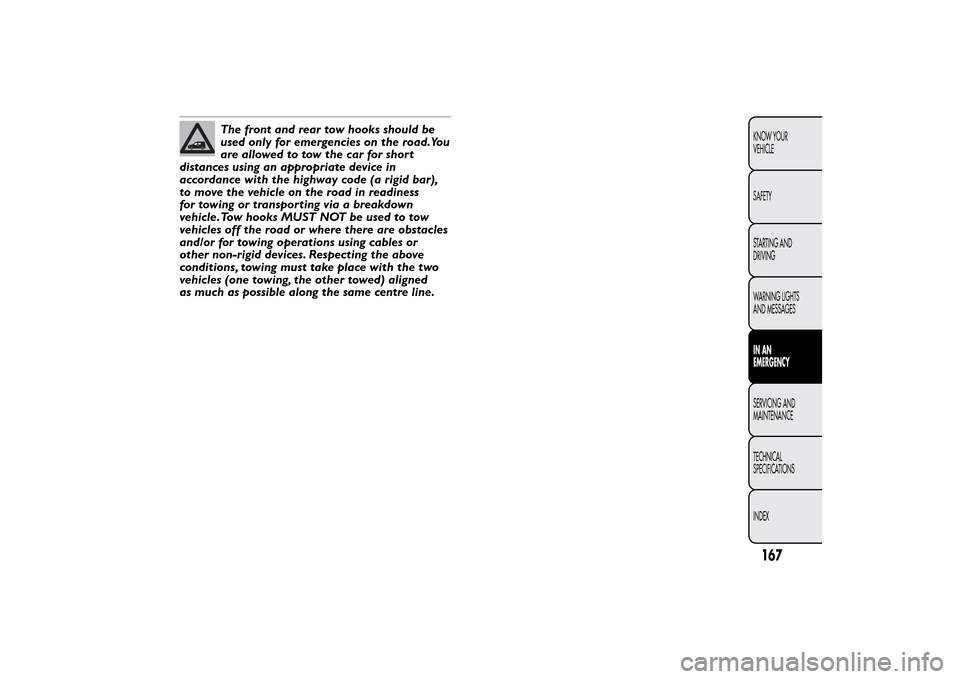
The front and rear tow hooks should be
used only for emergencies on the road.You
are allowed to tow the car for short
distances using an appropriate device in
accordance with the highway code (a rigid bar),
to move the vehicle on the road in readiness
for towing or transporting via a breakdown
vehicle.Tow hooks MUST NOT be used to tow
vehicles off the road or where there are obstacles
and/or for towing operations using cables or
other non-rigid devices. Respecting the above
conditions, towing must take place with the two
vehicles (one towing, the other towed) aligned
as much as possible along the same centre line.
167KNOW YOUR
VEHICLE
SAFETY
STARTING AND
DRIVING
WARNING LIGHTS
AND MESSAGESIN AN
EMERGENCYSERVICING AND
MAINTENANCE
TECHNICAL
SPECIFICATIONS
INDEX
Page 172 of 231
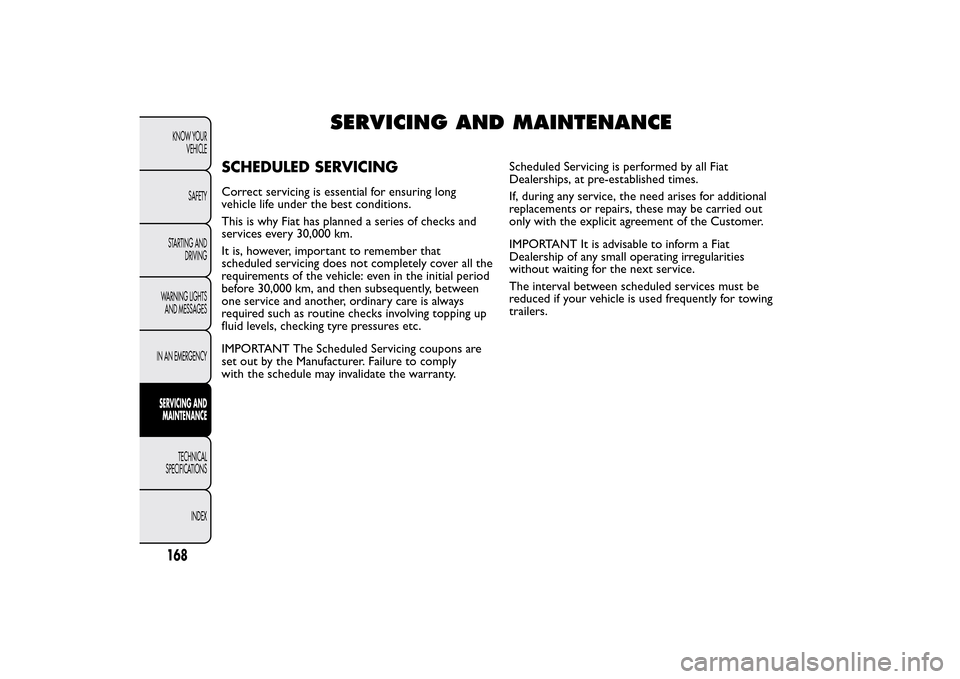
SERVICING AND MAINTENANCE
SCHEDULED SERVICINGCorrect servicing is essential for ensuring long
vehicle life under the best conditions.
This is why Fiat has planned a series of checks and
services every 30,000 km.
It is, however, important to remember that
scheduled servicing does not completely cover all the
requirements of the vehicle: even in the initial period
before 30,000 km, and then subsequently, between
one service and another, ordinary care is always
required such as routine checks involving topping up
fluid levels, checking tyre pressures etc.
IMPORTANT The Scheduled Servicing coupons are
set out by the Manufacturer. Failure to comply
with the schedule may invalidate the warranty.Scheduled Servicing is performed by all Fiat
Dealerships, at pre-established times.
If, during any service, the need arises for additional
replacements or repairs, these may be carried out
only with the explicit agreement of the Customer.
IMPORTANT It is advisable to inform a Fiat
Dealership of any small operating irregularities
without waiting for the next service.
The interval between scheduled services must be
reduced if your vehicle is used frequently for towing
trailers.
168KNOW YOUR
VEHICLE
SAFETY
STARTING AND
DRIVING
WARNING LIGHTS
AND MESSAGES
IN AN EMERGENCY
SERVICING AND
MAINTENANCE
TECHNICAL
SPECIFICATIONS
INDEX
Page 173 of 231
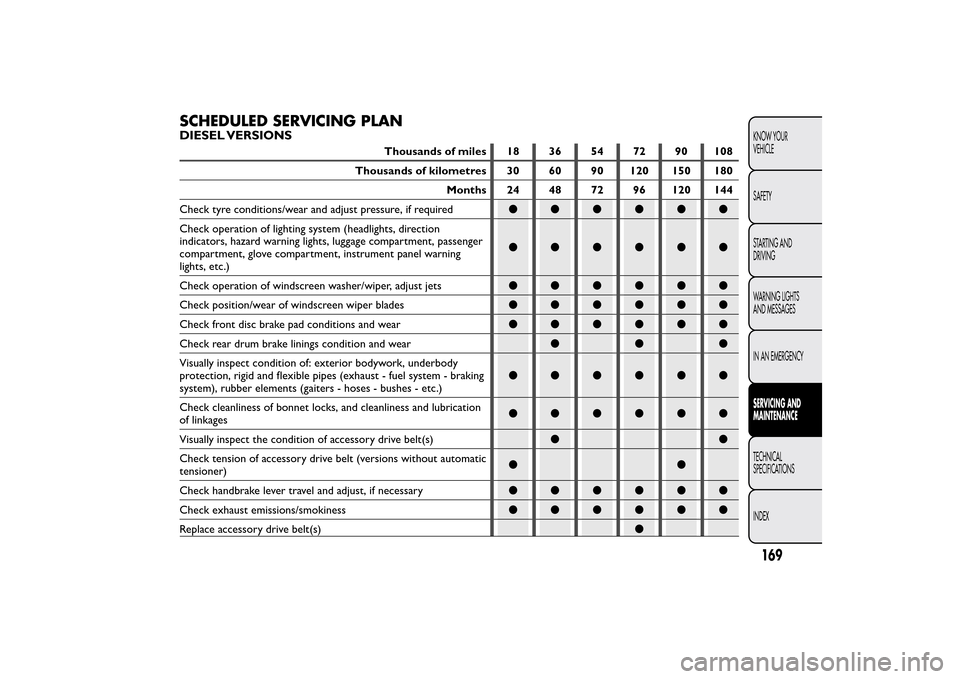
SCHEDULED SERVICING PLANDIESEL VERSIONS
Thousands of miles 18 36 54 72 90 108
Thousands of kilometres 30 60 90 120 150 180
Months 24 48 72 96 120 144
Check tyre conditions/wear and adjust pressure, if required●●●●●●
Check operation of lighting system (headlights, direction
indicators, hazard warning lights, luggage compartment, passenger
compartment, glove compartment, instrument panel warning
lights, etc.)●●●●●●
Check operation of windscreen washer/wiper, adjust jets●●●●●●
Check position/wear of windscreen wiper blades●●●●●●
Check front disc brake pad conditions and wear●●●●●●
Check rear drum brake linings condition and wear●●●
Visually inspect condition of: exterior bodywork, underbody
protection, rigid and flexible pipes (exhaust - fuel system - braking
system), rubber elements (gaiters - hoses - bushes - etc.)●●●●●●
Check cleanliness of bonnet locks, and cleanliness and lubrication
of linkages●●●●●●
Visually inspect the condition of accessory drive belt(s)●●
Check tension of accessory drive belt (versions without automatic
tensioner)●●
Check handbrake lever travel and adjust, if necessary●●●●●●
Check exhaust emissions/smokiness●●●●●●
Replace accessory drive belt(s)●
169KNOW YOUR
VEHICLE
SAFETY
STARTING AND
DRIVING
WARNING LIGHTS
AND MESSAGES
IN AN EMERGENCYSERVICING AND
MAINTENANCETECHNICAL
SPECIFICATIONS
INDEX
Page 174 of 231
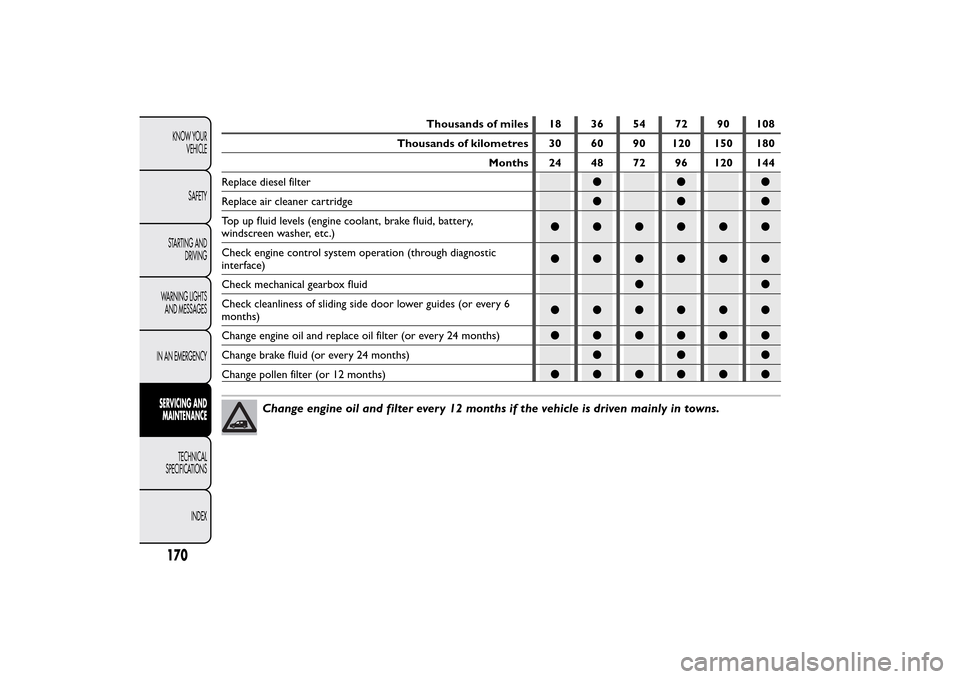
Thousands of miles 18 36 54 72 90 108
Thousands of kilometres 30 60 90 120 150 180
Months 24 48 72 96 120 144
Replace diesel filter●●●
Replace air cleaner cartridge●●●
Top up fluid levels (engine coolant, brake fluid, battery,
windscreen washer, etc.)●●●●●●
Check engine control system operation (through diagnostic
interface)●●●●●●
Check mechanical gearbox fluid●●
Check cleanliness of sliding side door lower guides (or every 6
months)●●●●●●
Change engine oil and replace oil filter (or every 24 months)●●●●●●
Change brake fluid (or every 24 months)●●●
Change pollen filter (or 12 months)●●●●●●
Change engine oil and filter ever y 12 months if the vehicle is driven mainly in towns.
170KNOW YOUR
VEHICLE
SAFETY
STARTING AND
DRIVING
WARNING LIGHTS
AND MESSAGES
IN AN EMERGENCY
SERVICING AND
MAINTENANCE
TECHNICAL
SPECIFICATIONS
INDEX
Page 175 of 231
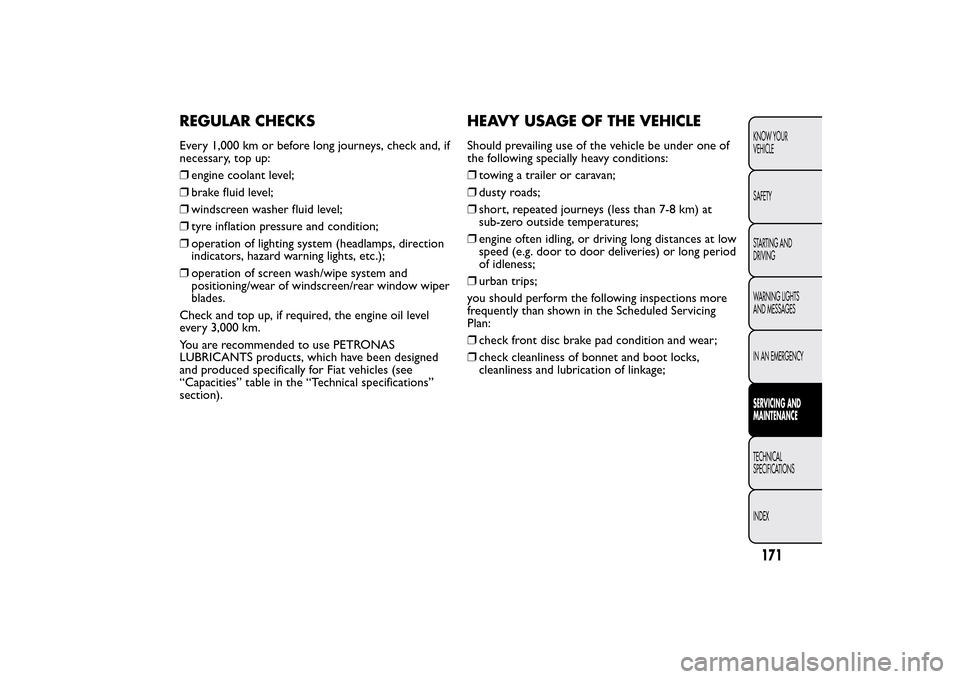
REGULAR CHECKSEvery 1,000 km or before long journeys, check and, if
necessary, top up:
❒engine coolant level;
❒brake fluid level;
❒windscreen washer fluid level;
❒tyre inflation pressure and condition;
❒operation of lighting system (headlamps, direction
indicators, hazard warning lights, etc.);
❒operation of screen wash/wipe system and
positioning/wear of windscreen/rear window wiper
blades.
Check and top up, if required, the engine oil level
every 3,000 km.
You are recommended to use PETRONAS
LUBRICANTS products, which have been designed
and produced specifically for Fiat vehicles (see
“Capacities” table in the “Technical specifications”
section).
HEAVY USAGE OF THE VEHICLEShould prevailing use of the vehicle be under one of
the following specially heavy conditions:
❒towing a trailer or caravan;
❒dusty roads;
❒short, repeated journeys (less than 7-8 km) at
sub-zero outside temperatures;
❒engine often idling, or driving long distances at low
speed (e.g. door to door deliveries) or long period
of idleness;
❒urban trips;
you should perform the following inspections more
frequently than shown in the Scheduled Servicing
Plan:
❒check front disc brake pad condition and wear;
❒check cleanliness of bonnet and boot locks,
cleanliness and lubrication of linkage;
171KNOW YOUR
VEHICLE
SAFETY
STARTING AND
DRIVING
WARNING LIGHTS
AND MESSAGES
IN AN EMERGENCYSERVICING AND
MAINTENANCETECHNICAL
SPECIFICATIONS
INDEX
Page 176 of 231
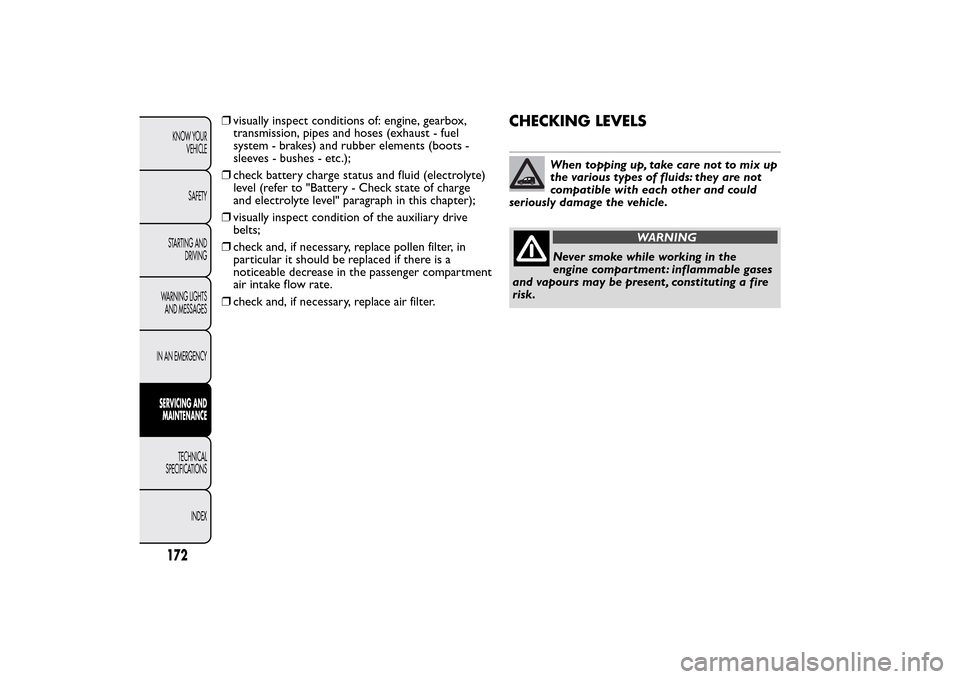
❒visually inspect conditions of: engine, gearbox,
transmission, pipes and hoses (exhaust - fuel
system - brakes) and rubber elements (boots -
sleeves - bushes - etc.);
❒check battery charge status and fluid (electrolyte)
level (refer to "Battery - Check state of charge
and electrolyte level" paragraph in this chapter);
❒visually inspect condition of the auxiliary drive
belts;
❒check and, if necessary, replace pollen filter, in
particular it should be replaced if there is a
noticeable decrease in the passenger compartment
air intake flow rate.
❒check and, if necessary, replace air filter.
CHECKING LEVELS
When topping up, take care not to mix up
the various types of fluids: they are not
compatible with each other and could
seriously damage the vehicle.
WARNING
Never smoke while working in the
engine compar tment : inflammable gases
and vapours may be present , constituting a fire
risk.
172KNOW YOUR
VEHICLE
SAFETY
STARTING AND
DRIVING
WARNING LIGHTS
AND MESSAGES
IN AN EMERGENCY
SERVICING AND
MAINTENANCE
TECHNICAL
SPECIFICATIONS
INDEX
Page 177 of 231
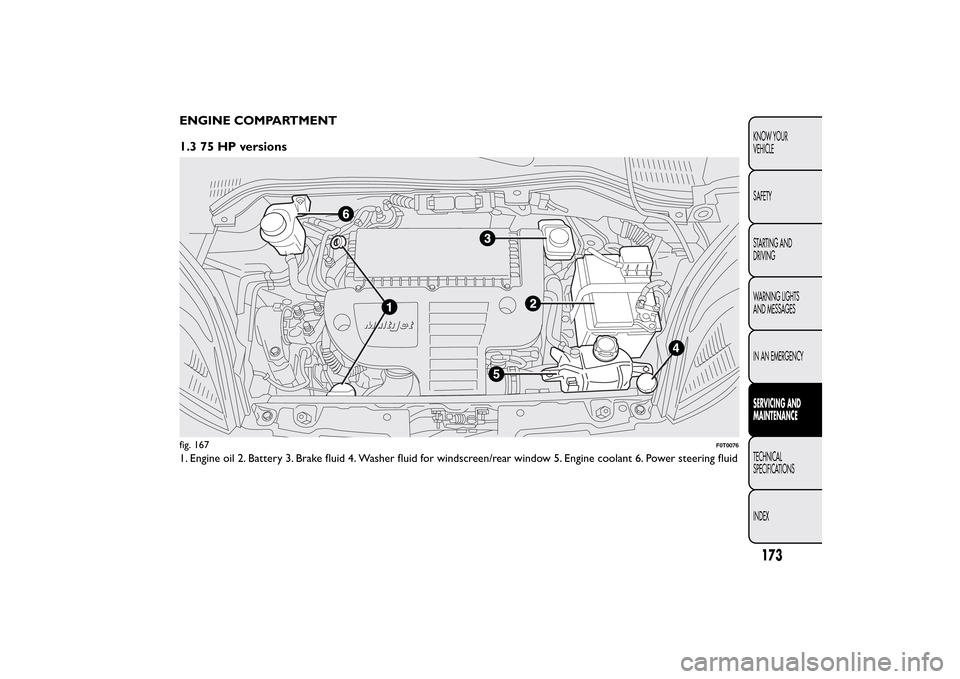
ENGINE COMPARTMENT
1.3 75 HP versions1. Engine oil 2. Battery 3. Brake fluid 4. Washer fluid for windscreen/rear window 5. Engine coolant 6. Power steering fluidfig. 167
F0T0076
173KNOW YOUR
VEHICLE
SAFETY
STARTING AND
DRIVING
WARNING LIGHTS
AND MESSAGES
IN AN EMERGENCYSERVICING AND
MAINTENANCETECHNICAL
SPECIFICATIONS
INDEX
Page 178 of 231
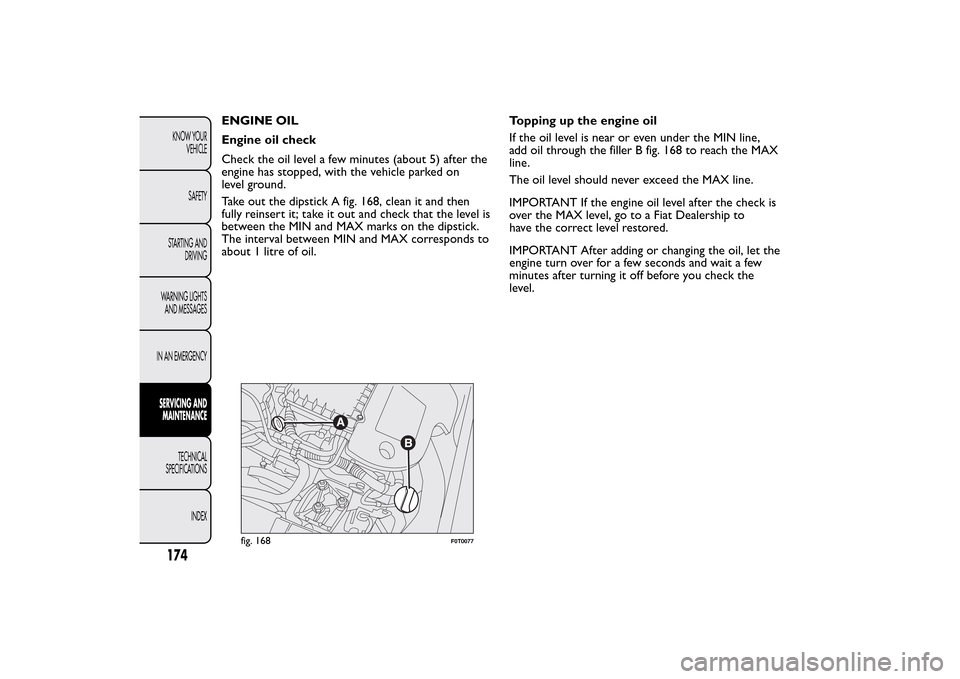
ENGINE OIL
Engine oil check
Check the oil level a few minutes (about 5) after the
engine has stopped, with the vehicle parked on
level ground.
Take out the dipstick A fig. 168, clean it and then
fully reinsert it; take it out and check that the level is
between the MIN and MAX marks on the dipstick.
The interval between MIN and MAX corresponds to
about 1 litre of oil.Topping up the engine oil
If the oil level is near or even under the MIN line,
add oil through the filler B fig. 168 to reach the MAX
line.
The oil level should never exceed the MAX line.
IMPORTANT If the engine oil level after the check is
over the MAX level, go to a Fiat Dealership to
have the correct level restored.
IMPORTANT After adding or changing the oil, let the
engine turn over for a few seconds and wait a few
minutes after turning it off before you check the
level.
fig. 168
F0T0077
174KNOW YOUR
VEHICLE
SAFETY
STARTING AND
DRIVING
WARNING LIGHTS
AND MESSAGES
IN AN EMERGENCY
SERVICING AND
MAINTENANCE
TECHNICAL
SPECIFICATIONS
INDEX
Page 179 of 231
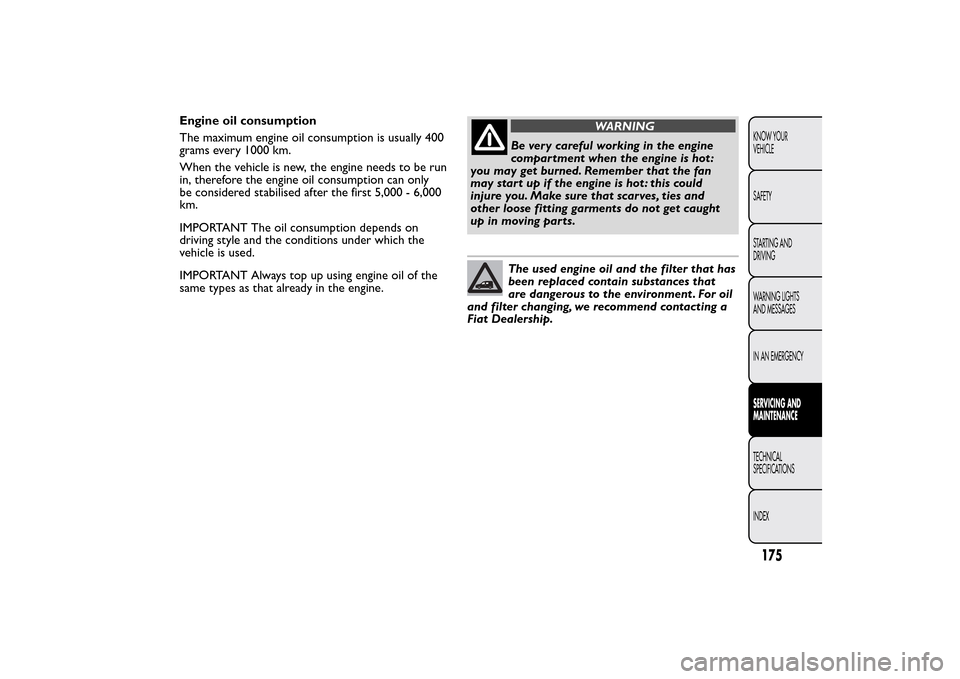
Engine oil consumption
The maximum engine oil consumption is usually 400
grams every 1000 km.
When the vehicle is new, the engine needs to be run
in, therefore the engine oil consumption can only
be considered stabilised after the first 5,000 - 6,000
km.
IMPORTANT The oil consumption depends on
driving style and the conditions under which the
vehicle is used.
IMPORTANT Always top up using engine oil of the
same types as that already in the engine.
WARNING
Be very careful working in the engine
compartment when the engine is hot :
you may get burned. Remember that the fan
may start up if the engine is hot : this could
injure you. Make sure that scarves, ties and
other loose fitting garments do not get caught
up in moving parts.The used engine oil and the filter that has
been replaced contain substances that
are dangerous to the environment . For oil
and filter changing, we recommend contacting a
Fiat Dealership.
175KNOW YOUR
VEHICLE
SAFETY
STARTING AND
DRIVING
WARNING LIGHTS
AND MESSAGES
IN AN EMERGENCYSERVICING AND
MAINTENANCETECHNICAL
SPECIFICATIONS
INDEX
Page 180 of 231

ENGINE COOLANT FLUID
The coolant level should be checked when the
engine is cold and should be between the MIN and
MAX lines on the vessel.
If the level is low, pour into the vessel through cap A
fig. 169 a 50% mixture of demineralised water and
PETRONAS LUBRICANTS PARAFLU
UP
.
The mixture of 50% PARAFLU
UP
and 50% distilled
water protects against freezing down to
temperatures of -35°C. For particularly harsh climate
conditions, we recommended using a mixture of
60% PARAFLU
UP
and 40% distilled water.
WARNING
Do not remove the tank cap when the
engine is very hot as there is a risk
of scalding.The cooling system is pressurised. If
the cap needs replacing, do so with another
original or the effectiveness of the system may
be compromised.PARAFLU
UP
antifreeze is used in the
engine cooling system. Use fluid of the
same type contained in the cooling system
for top-ups. PARAFLUUP
should not be mixed
with any other type of fluid. If this happens, do
not start the engine; contact a Fiat Dealership.
fig. 169
F0T0078
176KNOW YOUR
VEHICLE
SAFETY
STARTING AND
DRIVING
WARNING LIGHTS
AND MESSAGES
IN AN EMERGENCY
SERVICING AND
MAINTENANCE
TECHNICAL
SPECIFICATIONS
INDEX